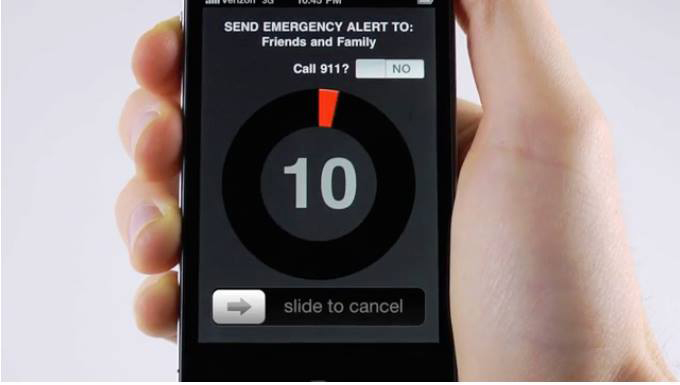Alexandra Tashman: UCPD app development should not be given priority over other safety measures

The Undergraduate Students Association Council’s Internal Vice President’s Office is planning a smartphone application to help address the problem of campus safety. The application is supposed to consist of a button that immediately alerts the University of California Police Department when it is pressed. Above, a photo of an application developed by Guardly, a company the IVP is considering partnering with.
By Alexandra Tashman
Oct. 10, 2013 12:49 a.m.
The original version of this article contained information that was unclear and had multiple errors and has been changed. See the bottom of the article for additional information.
It’s a Thursday night, and you’re walking from your friend’s apartment on Gayley to yours on Kelton. It’s dark, it’s late and you think someone may be following you. You’re scared.
Rather than fumbling around looking for the University of California Police Department number you saved somewhere in your phone during freshman orientation and then explaining where you are and what’s going on, you can simply open an app and press a big red button.
Instantly, UCPD knows who you are, where you are and is coming to help.

That’s the idea behind the panic button smartphone application currently being planned by the internal vice president’s office of the Undergraduate Students Association Council.
But as of now, it’s just an idea and it faces some impediments to becoming a reality. The primary problem with pursuing a panic button application before tackling other safety concerns is first, the cost.
Not only does the app need to be funded properly, but it also needs to be funded from a sustainable source since it requires a yearly renewal fee.
Making such an app available to the entire UCLA community could cost up to $60,000 annually, said USAC Internal Vice President Avi Oved.
Moreover, administrators and student government officials are currently unsure where the funding for the application would come from, though Oved said one potential option would be to fund the app through the Student Risk Education Committee.
Although the application is an excellent idea, there are other more immediate and less expensive means of increasing student safety that must be pursued first, before making the hefty financial commitment.
Moreover, the application would take time to roll out, as the IVP’s office hopes to secure specific features for the best possible price. At best, Oved said, the app could be ready as soon as the end of this school year, but most likely would not be released until next year.
Unfortunately, crime doesn’t wait for USAC to bargain with application developers.
The recent publication of the 2012 Jeanne Clery report for campus crime statistics showed that the number of robberies and hate crimes that occurred on UCLA property or in the surrounding area increased over the last year. Perhaps most tellingly, the number of reported aggravated assaults more than tripled from 10 to 35 cases between 2011 and 2012.
The need for increased safety measures is exacerbated by recent incidents that have occurred in the last two weeks alone, including the arrest of one man accused of attempting to sexually assault two students near the residential halls, and another incident where a man tried to grab a student in front of Sproul Hall.
Given the amount of crime that has occurred on campus since zero week, the need for improved safety measures is obvious and urgent.
One easily achievable improvement would be increasing the amount of lighting on UCLA’s campus and around the residential halls. This is an issue related to student safety that is discussed year after year, but perennially gets buried in red tape.
While improving lighting on the Hill would have to be an effort coordinated with the Office of Residential Life, it is a one-time solution that would cost the university less in the long run than a safety app and make students feel significantly more comfortable at night.
In terms of improving light on campus, Arthur Kirkland, the director of UCLA’s Office of Emergency Management, suggested that one way to improve campus safety would be to organize an evening when student leaders would meet with administrators on campus at night and do a walkthrough to show the areas that feel unsafe and need more visibility.
Students at UC Berkeley have already taken similar measures, which included coordinating between campus and city officials.
The UCLA community needs to improve safety sooner rather than later, and pursuing other options before making a costly commitment is essential.
The safety application is an excellent idea to increase campus safety, but it shouldn’t be the only heavily pursued route to a safer campus, especially if cheaper options are available or if multiple options can be pursued at once.
Correction: The original version of this article implied that the panic button smartphone application was currently in development. The USAC internal vice president’s office has not yet secured the funds for the application and has not hired a company to host the application. The cost of the application will vary depending on which groups are offered the service. The word annually was misspelled.


